Analysis of Managing Business Performance: A Financial Report
VerifiedAdded on 2023/01/12
|18
|3500
|40
Report
AI Summary
This report provides a comprehensive analysis of managing business performance, focusing on standard costing and its application in financial analysis. Part I utilizes marginal costing statements to evaluate the impact of changes in selling price and variable costs on net profit, including break-even point calculations under various scenarios. The analysis extends to margin of safety and net profit margins, offering insights into business profitability and risk. Part II delves into the concept of standard costing, explaining its meaning and the process of setting standard costs, including material and labor variances. It explores factors leading to favorable and adverse variances in labor and material costs, and critically assesses standard costing as a tool for ensuring control within a business. The report concludes with a discussion of the results and limitations of the exercises, providing a balanced perspective on the effectiveness of these financial tools.
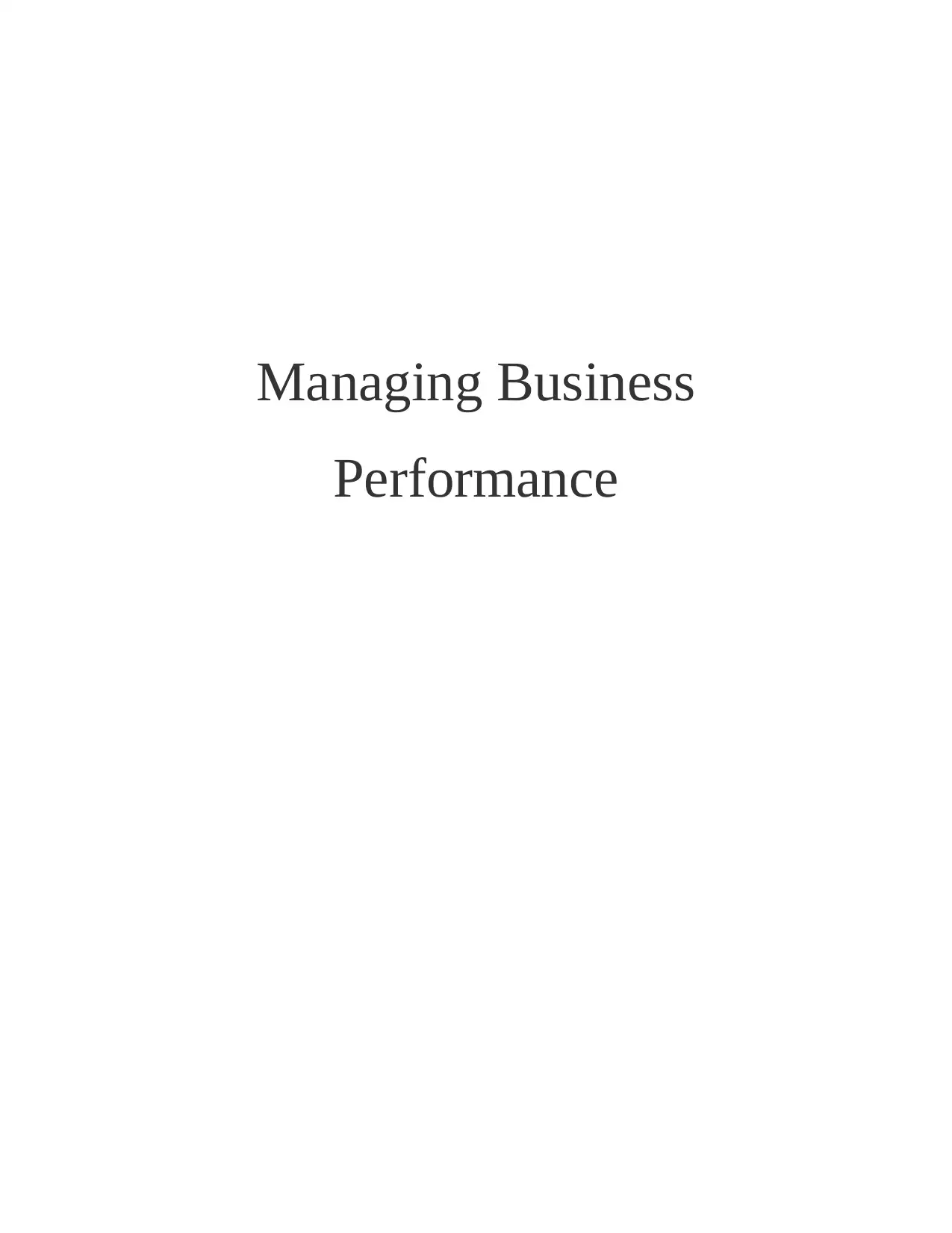
Managing Business
Performance
Performance
Paraphrase This Document
Need a fresh take? Get an instant paraphrase of this document with our AI Paraphraser
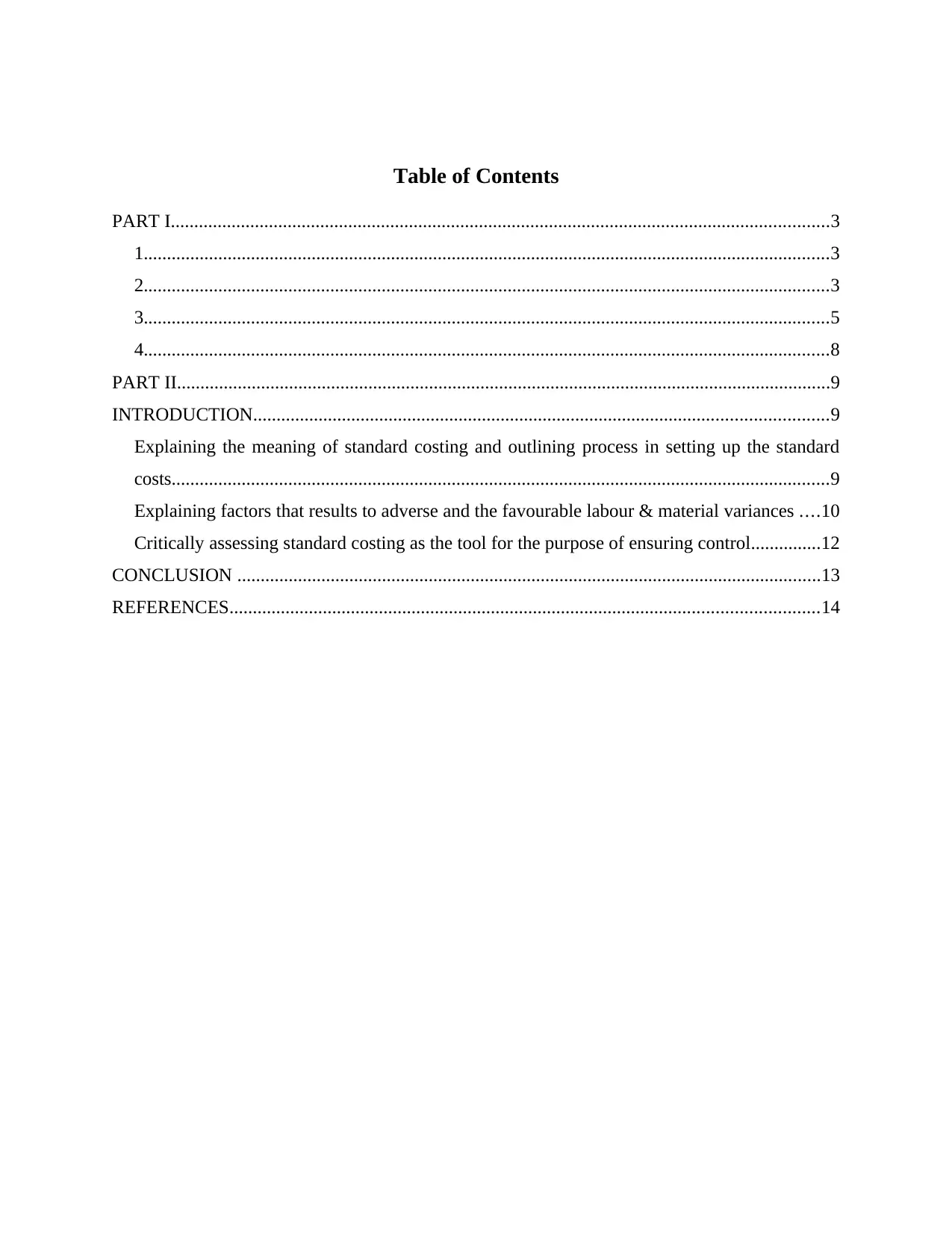
Table of Contents
PART I.............................................................................................................................................3
1...................................................................................................................................................3
2...................................................................................................................................................3
3...................................................................................................................................................5
4...................................................................................................................................................8
PART II............................................................................................................................................9
INTRODUCTION...........................................................................................................................9
Explaining the meaning of standard costing and outlining process in setting up the standard
costs.............................................................................................................................................9
Explaining factors that results to adverse and the favourable labour & material variances ....10
Critically assessing standard costing as the tool for the purpose of ensuring control...............12
CONCLUSION .............................................................................................................................13
REFERENCES..............................................................................................................................14
PART I.............................................................................................................................................3
1...................................................................................................................................................3
2...................................................................................................................................................3
3...................................................................................................................................................5
4...................................................................................................................................................8
PART II............................................................................................................................................9
INTRODUCTION...........................................................................................................................9
Explaining the meaning of standard costing and outlining process in setting up the standard
costs.............................................................................................................................................9
Explaining factors that results to adverse and the favourable labour & material variances ....10
Critically assessing standard costing as the tool for the purpose of ensuring control...............12
CONCLUSION .............................................................................................................................13
REFERENCES..............................................................................................................................14
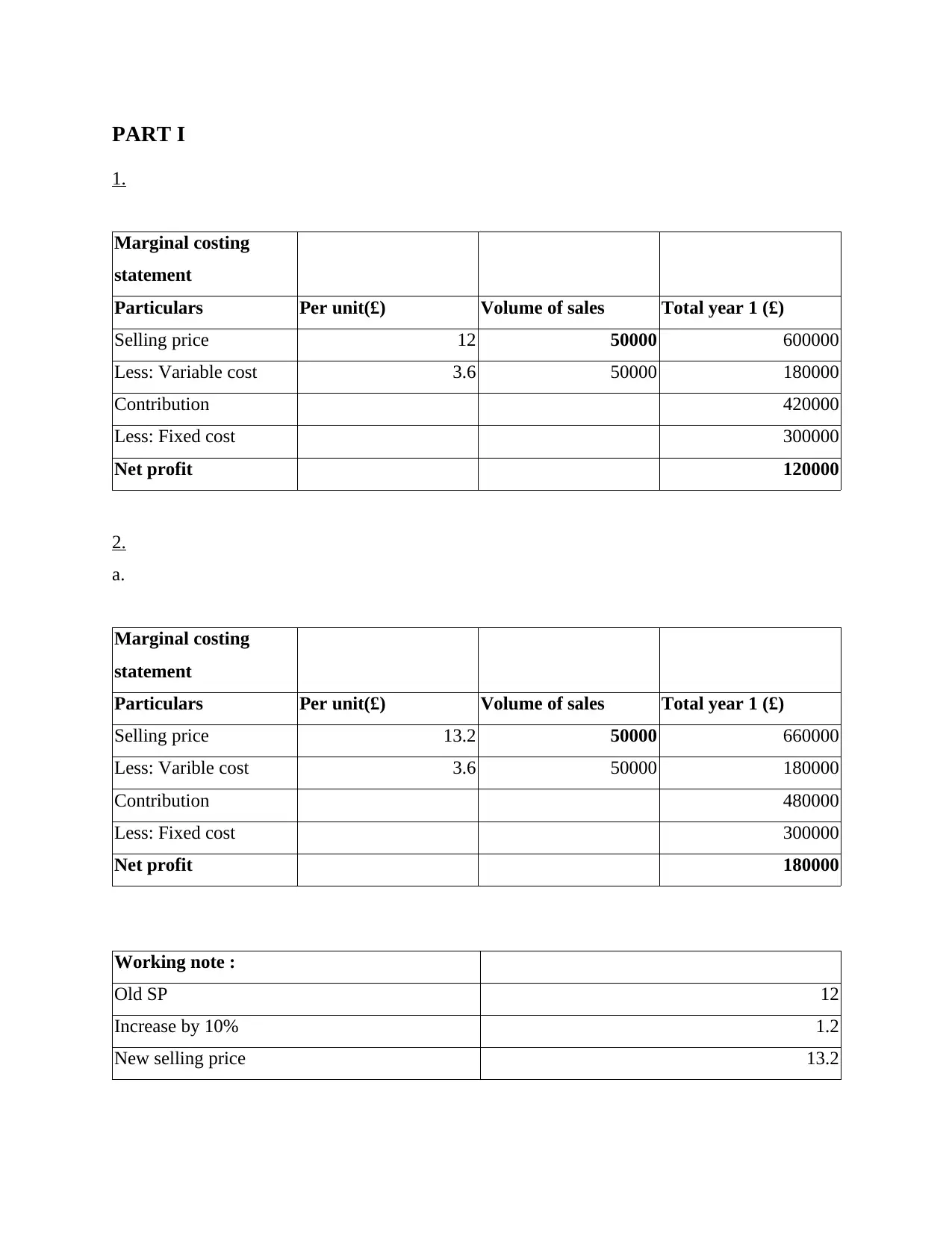
PART I
1.
Marginal costing
statement
Particulars Per unit(£) Volume of sales Total year 1 (£)
Selling price 12 50000 600000
Less: Variable cost 3.6 50000 180000
Contribution 420000
Less: Fixed cost 300000
Net profit 120000
2.
a.
Marginal costing
statement
Particulars Per unit(£) Volume of sales Total year 1 (£)
Selling price 13.2 50000 660000
Less: Varible cost 3.6 50000 180000
Contribution 480000
Less: Fixed cost 300000
Net profit 180000
Working note :
Old SP 12
Increase by 10% 1.2
New selling price 13.2
1.
Marginal costing
statement
Particulars Per unit(£) Volume of sales Total year 1 (£)
Selling price 12 50000 600000
Less: Variable cost 3.6 50000 180000
Contribution 420000
Less: Fixed cost 300000
Net profit 120000
2.
a.
Marginal costing
statement
Particulars Per unit(£) Volume of sales Total year 1 (£)
Selling price 13.2 50000 660000
Less: Varible cost 3.6 50000 180000
Contribution 480000
Less: Fixed cost 300000
Net profit 180000
Working note :
Old SP 12
Increase by 10% 1.2
New selling price 13.2
⊘ This is a preview!⊘
Do you want full access?
Subscribe today to unlock all pages.

Trusted by 1+ million students worldwide

b.
Marginal costing
statement
Particulars Per unit(£) Volume of sales Total year 1 (£)
Selling price 10.8 50000 540000
Less: Varible cost 3.6 50000 180000
Contribution 360000
Less: Fixed cost 300000
Net profit 60000
Working note :
Old SP 12
decrease by 10% 1.2
New selling price 10.8
c.
Marginal costing
statement
Particulars Per unit(£) Volume of sales Total year 1 (£)
Selling price 12 50000 600000
Less: Varible cost 3 50000 150000
Contribution 450000
Less: Fixed cost 300000
Net profit 150000
Working note :
SP 12
Marginal costing
statement
Particulars Per unit(£) Volume of sales Total year 1 (£)
Selling price 10.8 50000 540000
Less: Varible cost 3.6 50000 180000
Contribution 360000
Less: Fixed cost 300000
Net profit 60000
Working note :
Old SP 12
decrease by 10% 1.2
New selling price 10.8
c.
Marginal costing
statement
Particulars Per unit(£) Volume of sales Total year 1 (£)
Selling price 12 50000 600000
Less: Varible cost 3 50000 150000
Contribution 450000
Less: Fixed cost 300000
Net profit 150000
Working note :
SP 12
Paraphrase This Document
Need a fresh take? Get an instant paraphrase of this document with our AI Paraphraser
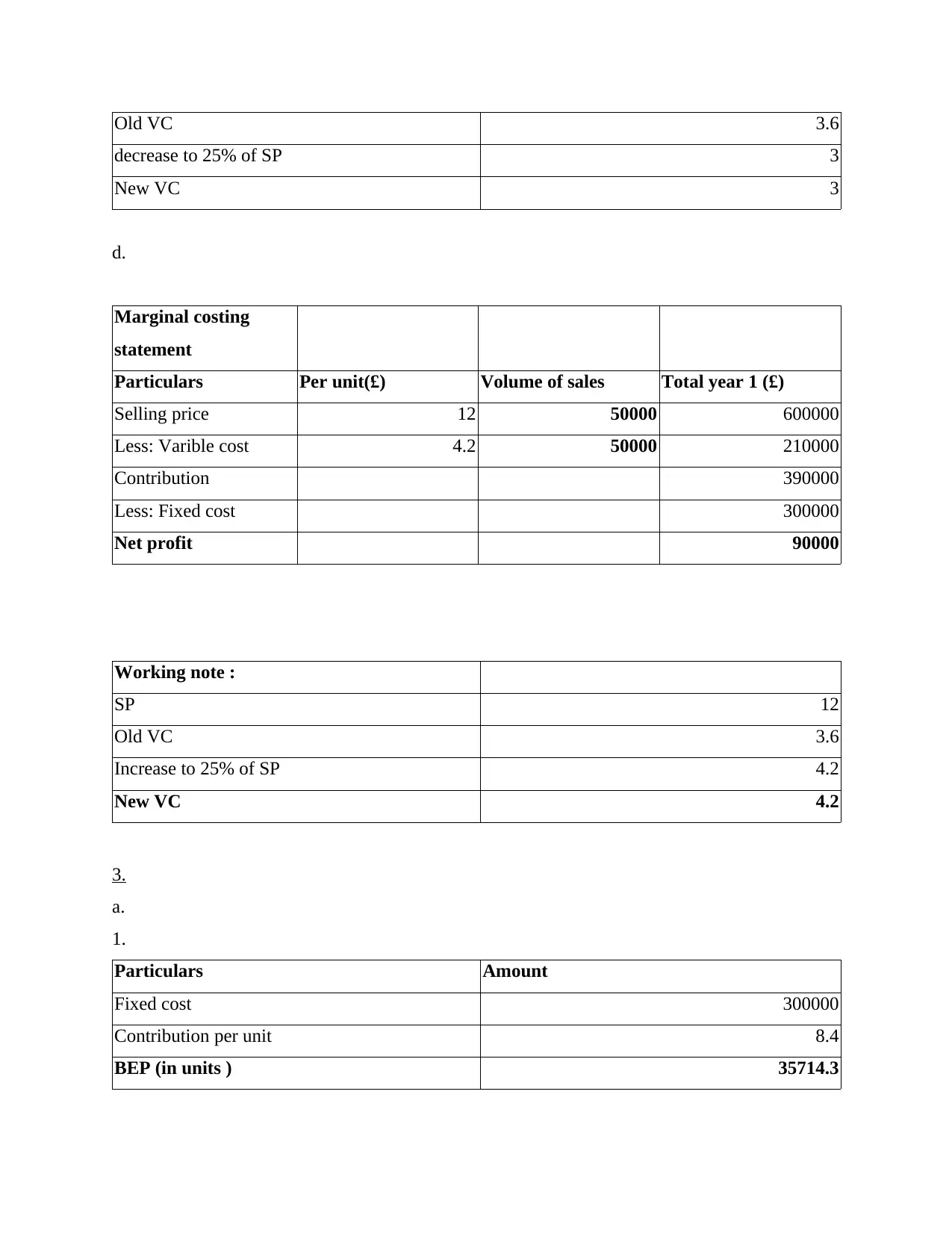
Old VC 3.6
decrease to 25% of SP 3
New VC 3
d.
Marginal costing
statement
Particulars Per unit(£) Volume of sales Total year 1 (£)
Selling price 12 50000 600000
Less: Varible cost 4.2 50000 210000
Contribution 390000
Less: Fixed cost 300000
Net profit 90000
Working note :
SP 12
Old VC 3.6
Increase to 25% of SP 4.2
New VC 4.2
3.
a.
1.
Particulars Amount
Fixed cost 300000
Contribution per unit 8.4
BEP (in units ) 35714.3
decrease to 25% of SP 3
New VC 3
d.
Marginal costing
statement
Particulars Per unit(£) Volume of sales Total year 1 (£)
Selling price 12 50000 600000
Less: Varible cost 4.2 50000 210000
Contribution 390000
Less: Fixed cost 300000
Net profit 90000
Working note :
SP 12
Old VC 3.6
Increase to 25% of SP 4.2
New VC 4.2
3.
a.
1.
Particulars Amount
Fixed cost 300000
Contribution per unit 8.4
BEP (in units ) 35714.3
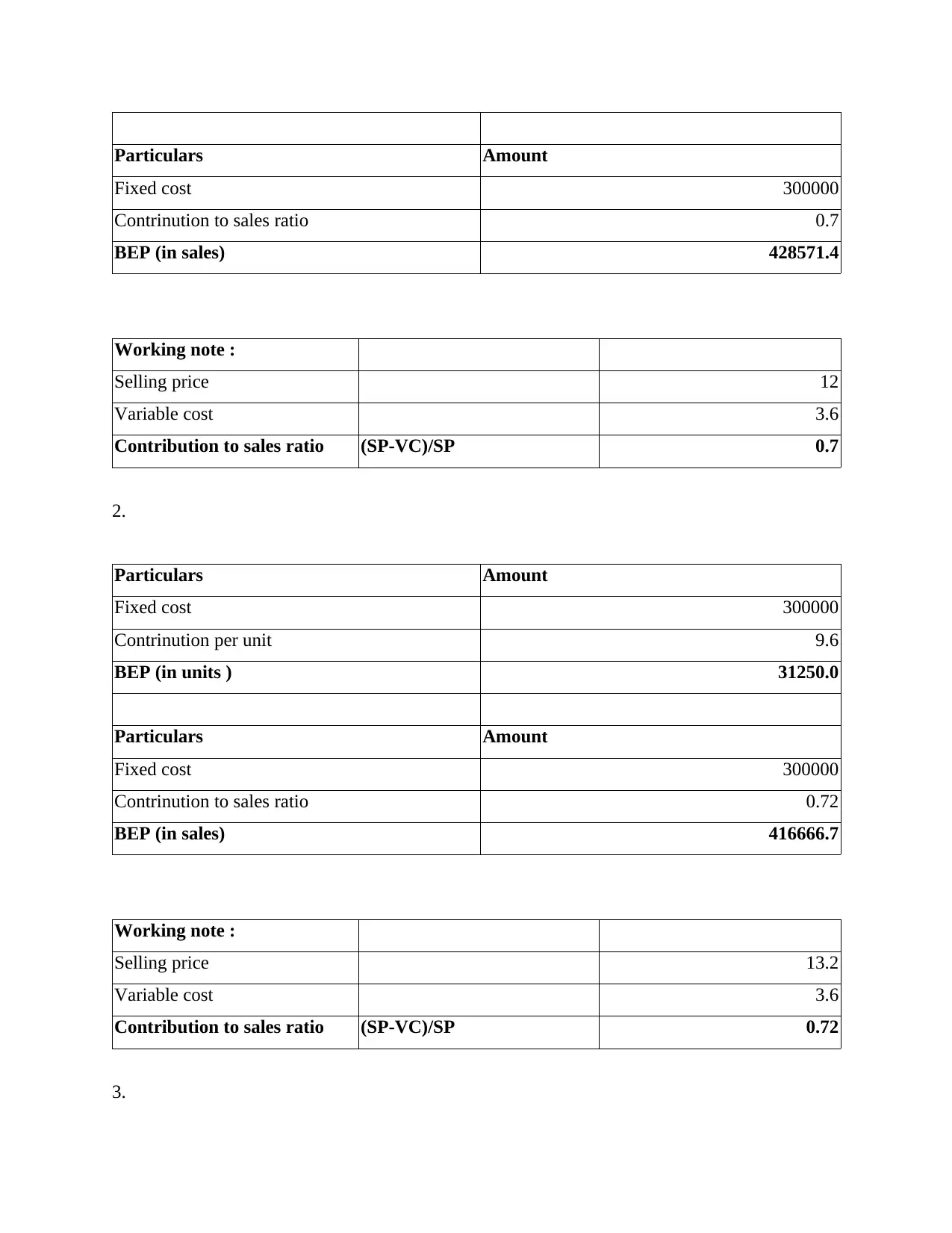
Particulars Amount
Fixed cost 300000
Contrinution to sales ratio 0.7
BEP (in sales) 428571.4
Working note :
Selling price 12
Variable cost 3.6
Contribution to sales ratio (SP-VC)/SP 0.7
2.
Particulars Amount
Fixed cost 300000
Contrinution per unit 9.6
BEP (in units ) 31250.0
Particulars Amount
Fixed cost 300000
Contrinution to sales ratio 0.72
BEP (in sales) 416666.7
Working note :
Selling price 13.2
Variable cost 3.6
Contribution to sales ratio (SP-VC)/SP 0.72
3.
Fixed cost 300000
Contrinution to sales ratio 0.7
BEP (in sales) 428571.4
Working note :
Selling price 12
Variable cost 3.6
Contribution to sales ratio (SP-VC)/SP 0.7
2.
Particulars Amount
Fixed cost 300000
Contrinution per unit 9.6
BEP (in units ) 31250.0
Particulars Amount
Fixed cost 300000
Contrinution to sales ratio 0.72
BEP (in sales) 416666.7
Working note :
Selling price 13.2
Variable cost 3.6
Contribution to sales ratio (SP-VC)/SP 0.72
3.
⊘ This is a preview!⊘
Do you want full access?
Subscribe today to unlock all pages.

Trusted by 1+ million students worldwide
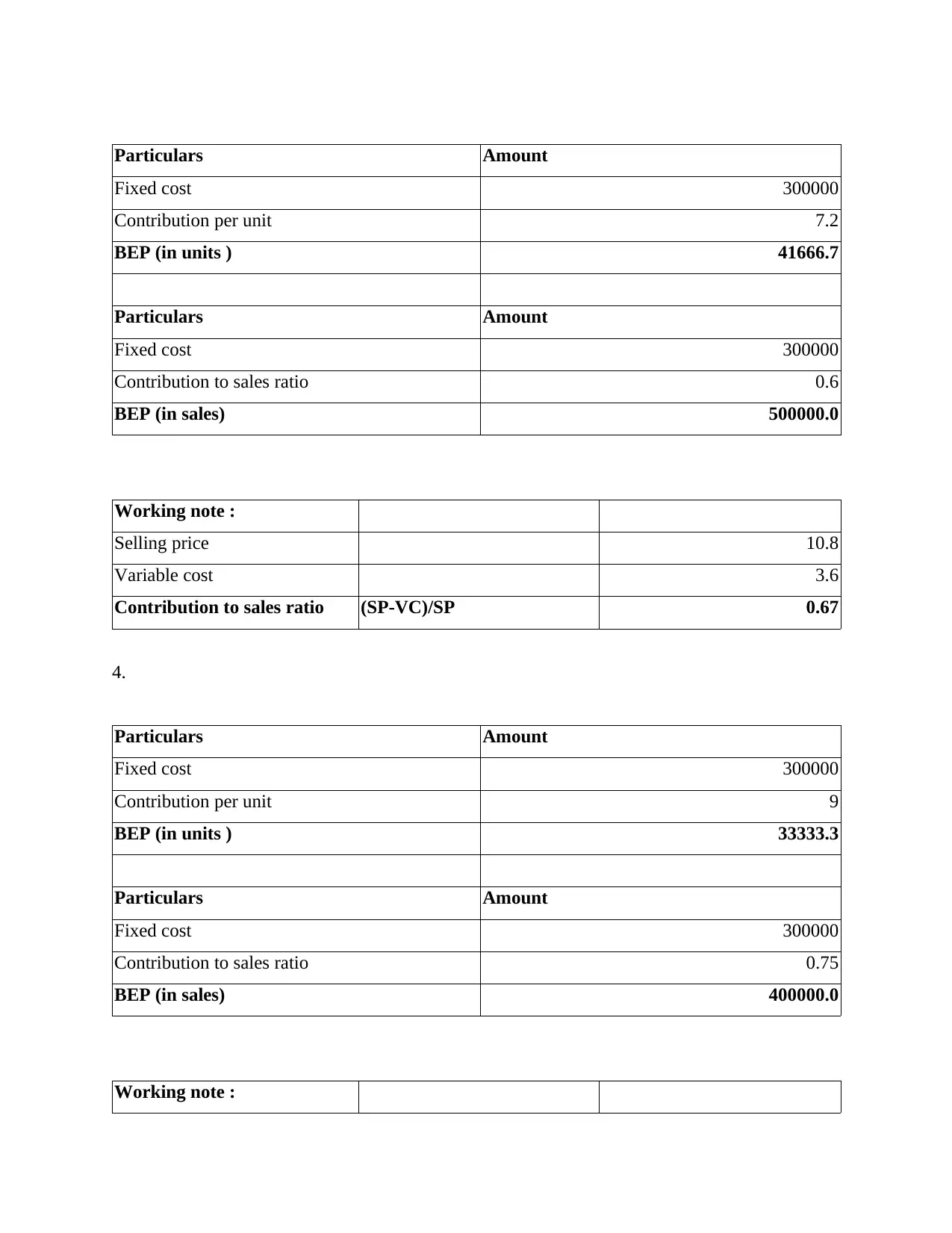
Particulars Amount
Fixed cost 300000
Contribution per unit 7.2
BEP (in units ) 41666.7
Particulars Amount
Fixed cost 300000
Contribution to sales ratio 0.6
BEP (in sales) 500000.0
Working note :
Selling price 10.8
Variable cost 3.6
Contribution to sales ratio (SP-VC)/SP 0.67
4.
Particulars Amount
Fixed cost 300000
Contribution per unit 9
BEP (in units ) 33333.3
Particulars Amount
Fixed cost 300000
Contribution to sales ratio 0.75
BEP (in sales) 400000.0
Working note :
Fixed cost 300000
Contribution per unit 7.2
BEP (in units ) 41666.7
Particulars Amount
Fixed cost 300000
Contribution to sales ratio 0.6
BEP (in sales) 500000.0
Working note :
Selling price 10.8
Variable cost 3.6
Contribution to sales ratio (SP-VC)/SP 0.67
4.
Particulars Amount
Fixed cost 300000
Contribution per unit 9
BEP (in units ) 33333.3
Particulars Amount
Fixed cost 300000
Contribution to sales ratio 0.75
BEP (in sales) 400000.0
Working note :
Paraphrase This Document
Need a fresh take? Get an instant paraphrase of this document with our AI Paraphraser
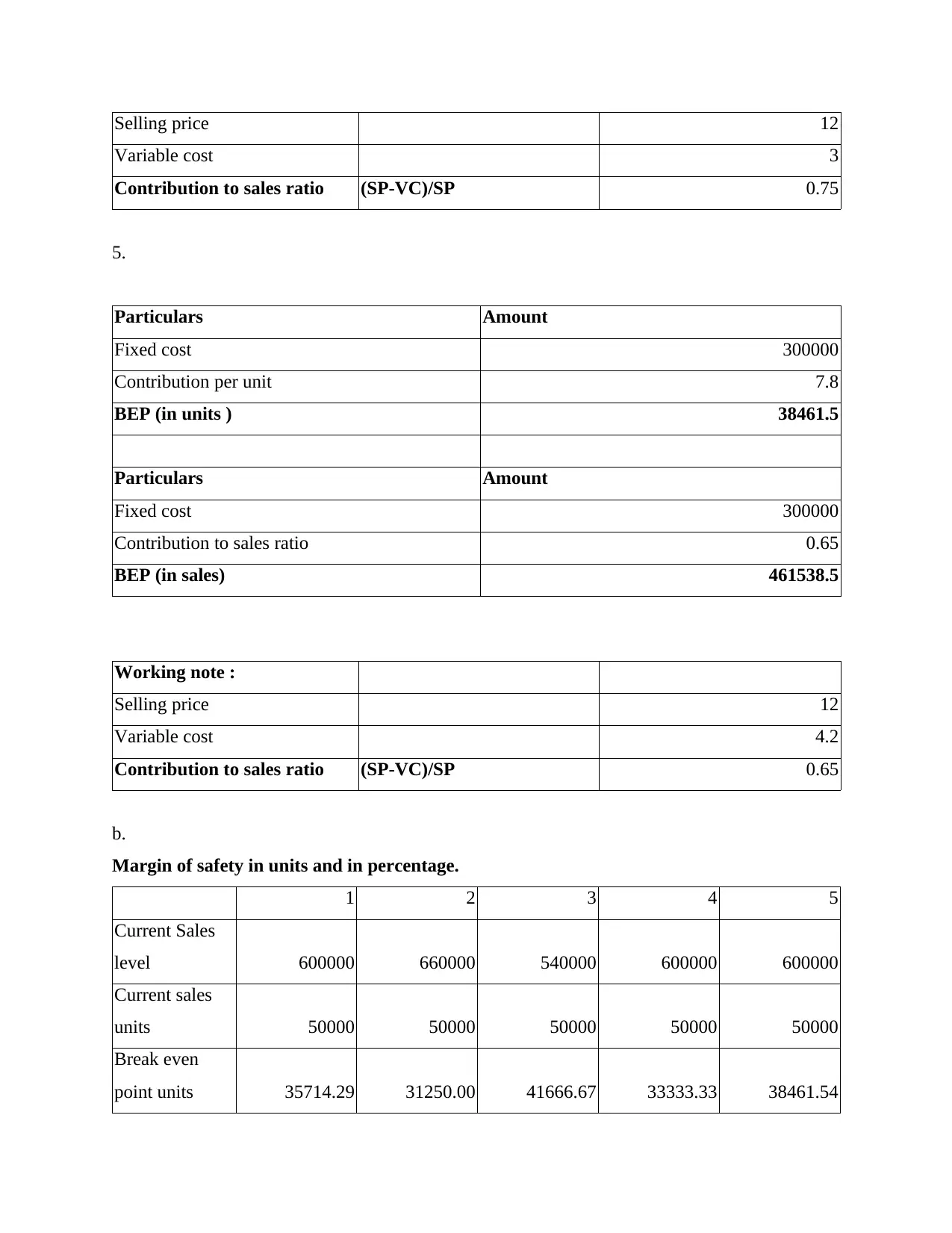
Selling price 12
Variable cost 3
Contribution to sales ratio (SP-VC)/SP 0.75
5.
Particulars Amount
Fixed cost 300000
Contribution per unit 7.8
BEP (in units ) 38461.5
Particulars Amount
Fixed cost 300000
Contribution to sales ratio 0.65
BEP (in sales) 461538.5
Working note :
Selling price 12
Variable cost 4.2
Contribution to sales ratio (SP-VC)/SP 0.65
b.
Margin of safety in units and in percentage.
1 2 3 4 5
Current Sales
level 600000 660000 540000 600000 600000
Current sales
units 50000 50000 50000 50000 50000
Break even
point units 35714.29 31250.00 41666.67 33333.33 38461.54
Variable cost 3
Contribution to sales ratio (SP-VC)/SP 0.75
5.
Particulars Amount
Fixed cost 300000
Contribution per unit 7.8
BEP (in units ) 38461.5
Particulars Amount
Fixed cost 300000
Contribution to sales ratio 0.65
BEP (in sales) 461538.5
Working note :
Selling price 12
Variable cost 4.2
Contribution to sales ratio (SP-VC)/SP 0.65
b.
Margin of safety in units and in percentage.
1 2 3 4 5
Current Sales
level 600000 660000 540000 600000 600000
Current sales
units 50000 50000 50000 50000 50000
Break even
point units 35714.29 31250.00 41666.67 33333.33 38461.54
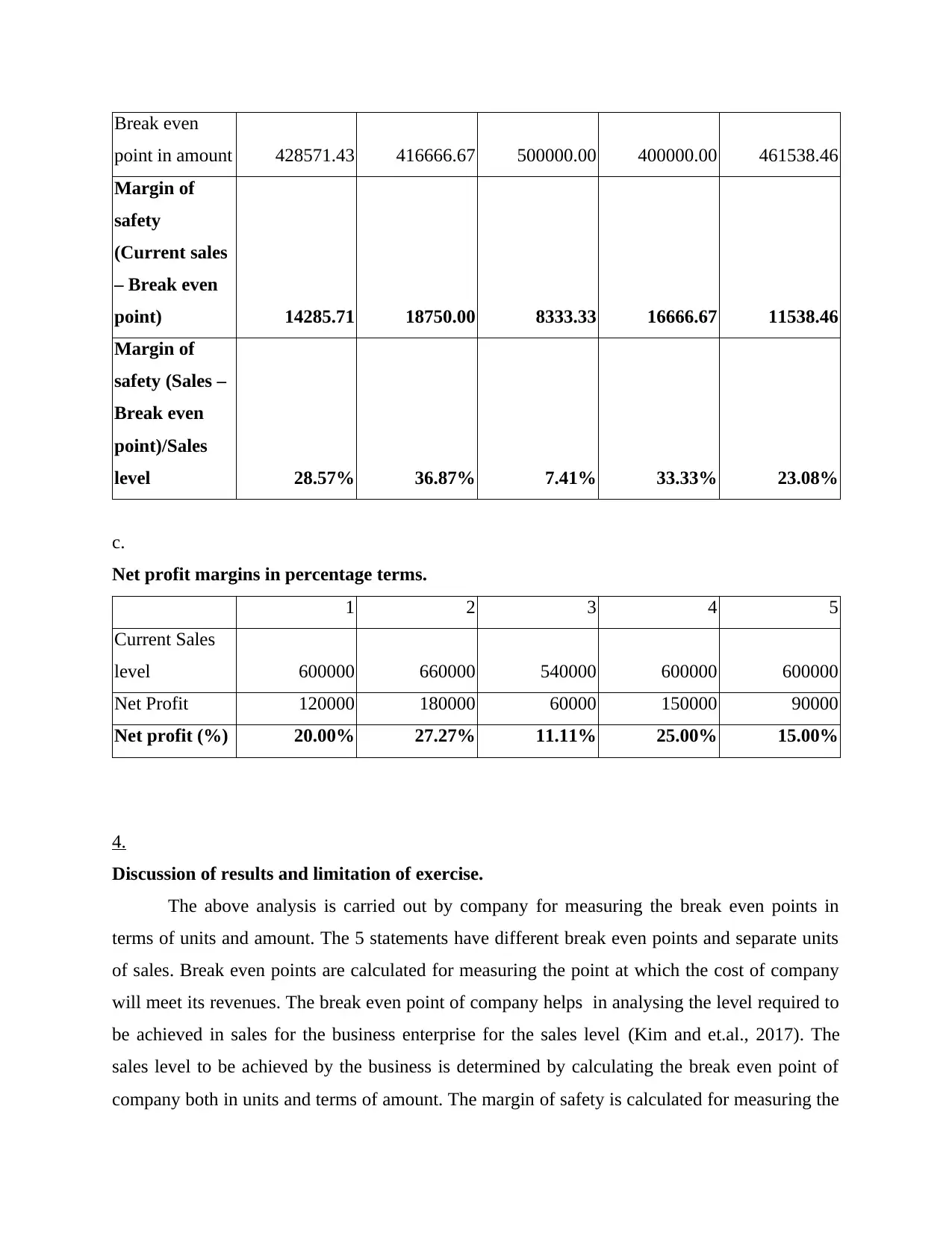
Break even
point in amount 428571.43 416666.67 500000.00 400000.00 461538.46
Margin of
safety
(Current sales
– Break even
point) 14285.71 18750.00 8333.33 16666.67 11538.46
Margin of
safety (Sales –
Break even
point)/Sales
level 28.57% 36.87% 7.41% 33.33% 23.08%
c.
Net profit margins in percentage terms.
1 2 3 4 5
Current Sales
level 600000 660000 540000 600000 600000
Net Profit 120000 180000 60000 150000 90000
Net profit (%) 20.00% 27.27% 11.11% 25.00% 15.00%
4.
Discussion of results and limitation of exercise.
The above analysis is carried out by company for measuring the break even points in
terms of units and amount. The 5 statements have different break even points and separate units
of sales. Break even points are calculated for measuring the point at which the cost of company
will meet its revenues. The break even point of company helps in analysing the level required to
be achieved in sales for the business enterprise for the sales level (Kim and et.al., 2017). The
sales level to be achieved by the business is determined by calculating the break even point of
company both in units and terms of amount. The margin of safety is calculated for measuring the
point in amount 428571.43 416666.67 500000.00 400000.00 461538.46
Margin of
safety
(Current sales
– Break even
point) 14285.71 18750.00 8333.33 16666.67 11538.46
Margin of
safety (Sales –
Break even
point)/Sales
level 28.57% 36.87% 7.41% 33.33% 23.08%
c.
Net profit margins in percentage terms.
1 2 3 4 5
Current Sales
level 600000 660000 540000 600000 600000
Net Profit 120000 180000 60000 150000 90000
Net profit (%) 20.00% 27.27% 11.11% 25.00% 15.00%
4.
Discussion of results and limitation of exercise.
The above analysis is carried out by company for measuring the break even points in
terms of units and amount. The 5 statements have different break even points and separate units
of sales. Break even points are calculated for measuring the point at which the cost of company
will meet its revenues. The break even point of company helps in analysing the level required to
be achieved in sales for the business enterprise for the sales level (Kim and et.al., 2017). The
sales level to be achieved by the business is determined by calculating the break even point of
company both in units and terms of amount. The margin of safety is calculated for measuring the
⊘ This is a preview!⊘
Do you want full access?
Subscribe today to unlock all pages.

Trusted by 1+ million students worldwide
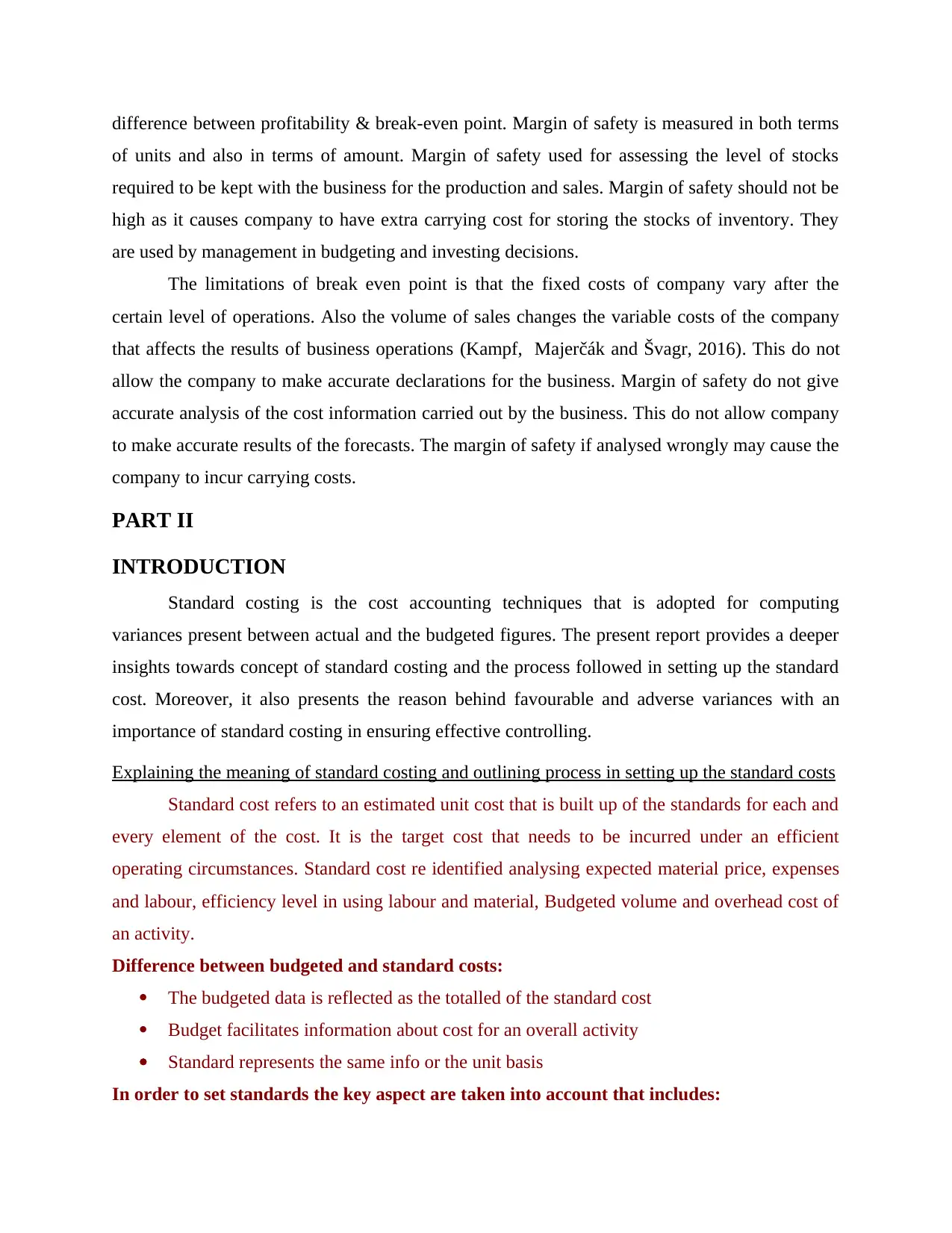
difference between profitability & break-even point. Margin of safety is measured in both terms
of units and also in terms of amount. Margin of safety used for assessing the level of stocks
required to be kept with the business for the production and sales. Margin of safety should not be
high as it causes company to have extra carrying cost for storing the stocks of inventory. They
are used by management in budgeting and investing decisions.
The limitations of break even point is that the fixed costs of company vary after the
certain level of operations. Also the volume of sales changes the variable costs of the company
that affects the results of business operations (Kampf, Majerčák and Švagr, 2016). This do not
allow the company to make accurate declarations for the business. Margin of safety do not give
accurate analysis of the cost information carried out by the business. This do not allow company
to make accurate results of the forecasts. The margin of safety if analysed wrongly may cause the
company to incur carrying costs.
PART II
INTRODUCTION
Standard costing is the cost accounting techniques that is adopted for computing
variances present between actual and the budgeted figures. The present report provides a deeper
insights towards concept of standard costing and the process followed in setting up the standard
cost. Moreover, it also presents the reason behind favourable and adverse variances with an
importance of standard costing in ensuring effective controlling.
Explaining the meaning of standard costing and outlining process in setting up the standard costs
Standard cost refers to an estimated unit cost that is built up of the standards for each and
every element of the cost. It is the target cost that needs to be incurred under an efficient
operating circumstances. Standard cost re identified analysing expected material price, expenses
and labour, efficiency level in using labour and material, Budgeted volume and overhead cost of
an activity.
Difference between budgeted and standard costs:
The budgeted data is reflected as the totalled of the standard cost
Budget facilitates information about cost for an overall activity
Standard represents the same info or the unit basis
In order to set standards the key aspect are taken into account that includes:
of units and also in terms of amount. Margin of safety used for assessing the level of stocks
required to be kept with the business for the production and sales. Margin of safety should not be
high as it causes company to have extra carrying cost for storing the stocks of inventory. They
are used by management in budgeting and investing decisions.
The limitations of break even point is that the fixed costs of company vary after the
certain level of operations. Also the volume of sales changes the variable costs of the company
that affects the results of business operations (Kampf, Majerčák and Švagr, 2016). This do not
allow the company to make accurate declarations for the business. Margin of safety do not give
accurate analysis of the cost information carried out by the business. This do not allow company
to make accurate results of the forecasts. The margin of safety if analysed wrongly may cause the
company to incur carrying costs.
PART II
INTRODUCTION
Standard costing is the cost accounting techniques that is adopted for computing
variances present between actual and the budgeted figures. The present report provides a deeper
insights towards concept of standard costing and the process followed in setting up the standard
cost. Moreover, it also presents the reason behind favourable and adverse variances with an
importance of standard costing in ensuring effective controlling.
Explaining the meaning of standard costing and outlining process in setting up the standard costs
Standard cost refers to an estimated unit cost that is built up of the standards for each and
every element of the cost. It is the target cost that needs to be incurred under an efficient
operating circumstances. Standard cost re identified analysing expected material price, expenses
and labour, efficiency level in using labour and material, Budgeted volume and overhead cost of
an activity.
Difference between budgeted and standard costs:
The budgeted data is reflected as the totalled of the standard cost
Budget facilitates information about cost for an overall activity
Standard represents the same info or the unit basis
In order to set standards the key aspect are taken into account that includes:
Paraphrase This Document
Need a fresh take? Get an instant paraphrase of this document with our AI Paraphraser
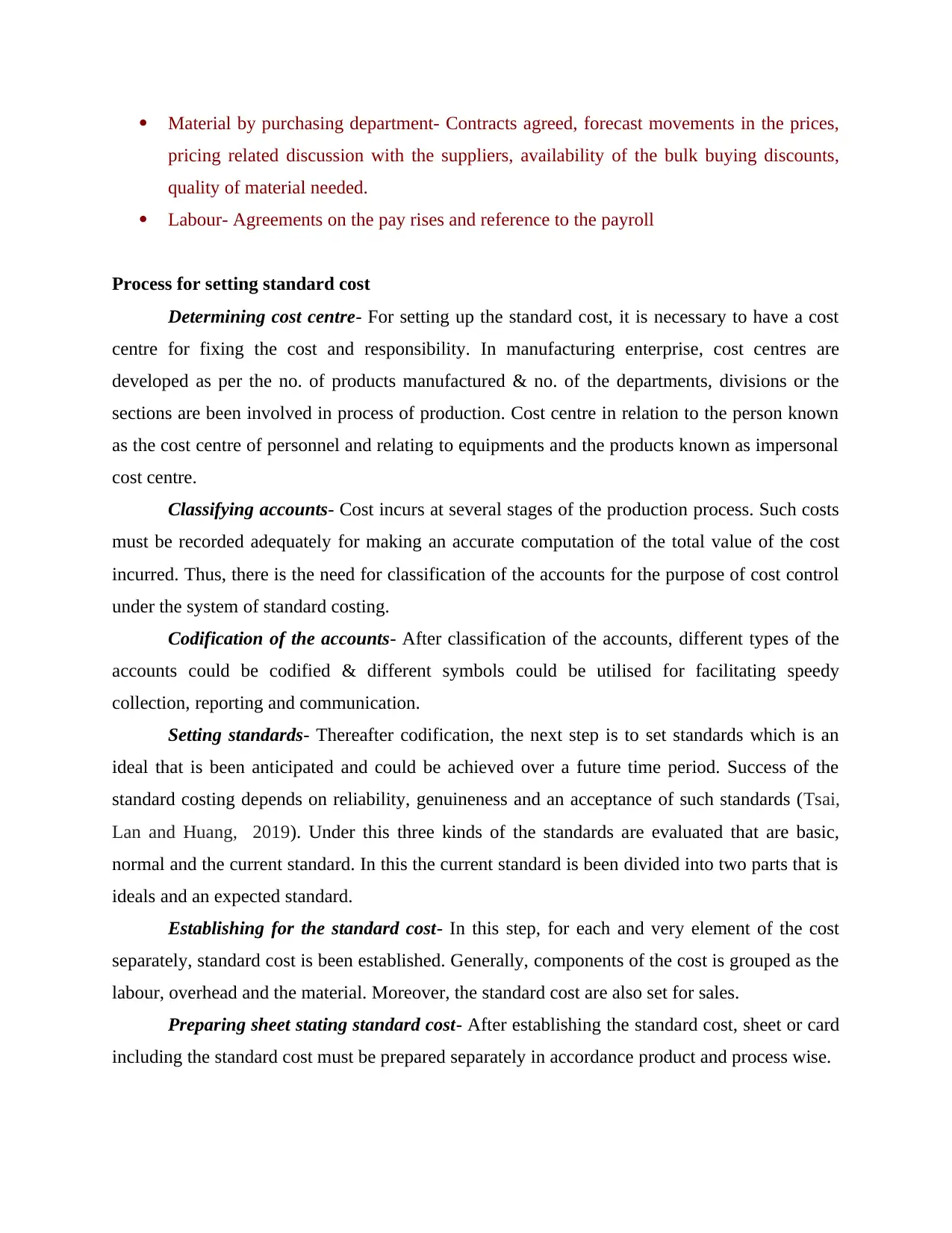
Material by purchasing department- Contracts agreed, forecast movements in the prices,
pricing related discussion with the suppliers, availability of the bulk buying discounts,
quality of material needed.
Labour- Agreements on the pay rises and reference to the payroll
Process for setting standard cost
Determining cost centre- For setting up the standard cost, it is necessary to have a cost
centre for fixing the cost and responsibility. In manufacturing enterprise, cost centres are
developed as per the no. of products manufactured & no. of the departments, divisions or the
sections are been involved in process of production. Cost centre in relation to the person known
as the cost centre of personnel and relating to equipments and the products known as impersonal
cost centre.
Classifying accounts- Cost incurs at several stages of the production process. Such costs
must be recorded adequately for making an accurate computation of the total value of the cost
incurred. Thus, there is the need for classification of the accounts for the purpose of cost control
under the system of standard costing.
Codification of the accounts- After classification of the accounts, different types of the
accounts could be codified & different symbols could be utilised for facilitating speedy
collection, reporting and communication.
Setting standards- Thereafter codification, the next step is to set standards which is an
ideal that is been anticipated and could be achieved over a future time period. Success of the
standard costing depends on reliability, genuineness and an acceptance of such standards (Tsai,
Lan and Huang, 2019). Under this three kinds of the standards are evaluated that are basic,
normal and the current standard. In this the current standard is been divided into two parts that is
ideals and an expected standard.
Establishing for the standard cost- In this step, for each and very element of the cost
separately, standard cost is been established. Generally, components of the cost is grouped as the
labour, overhead and the material. Moreover, the standard cost are also set for sales.
Preparing sheet stating standard cost- After establishing the standard cost, sheet or card
including the standard cost must be prepared separately in accordance product and process wise.
pricing related discussion with the suppliers, availability of the bulk buying discounts,
quality of material needed.
Labour- Agreements on the pay rises and reference to the payroll
Process for setting standard cost
Determining cost centre- For setting up the standard cost, it is necessary to have a cost
centre for fixing the cost and responsibility. In manufacturing enterprise, cost centres are
developed as per the no. of products manufactured & no. of the departments, divisions or the
sections are been involved in process of production. Cost centre in relation to the person known
as the cost centre of personnel and relating to equipments and the products known as impersonal
cost centre.
Classifying accounts- Cost incurs at several stages of the production process. Such costs
must be recorded adequately for making an accurate computation of the total value of the cost
incurred. Thus, there is the need for classification of the accounts for the purpose of cost control
under the system of standard costing.
Codification of the accounts- After classification of the accounts, different types of the
accounts could be codified & different symbols could be utilised for facilitating speedy
collection, reporting and communication.
Setting standards- Thereafter codification, the next step is to set standards which is an
ideal that is been anticipated and could be achieved over a future time period. Success of the
standard costing depends on reliability, genuineness and an acceptance of such standards (Tsai,
Lan and Huang, 2019). Under this three kinds of the standards are evaluated that are basic,
normal and the current standard. In this the current standard is been divided into two parts that is
ideals and an expected standard.
Establishing for the standard cost- In this step, for each and very element of the cost
separately, standard cost is been established. Generally, components of the cost is grouped as the
labour, overhead and the material. Moreover, the standard cost are also set for sales.
Preparing sheet stating standard cost- After establishing the standard cost, sheet or card
including the standard cost must be prepared separately in accordance product and process wise.

Explaining factors that results to adverse and the favourable labour & material variances
Labour variance
Labour rate variance focuses on comparing the actual hours for which the workers
worked in a particular time period with that of the proportion of cost using a standard cost for per
labour hour. Adverse labour rate variance resulted when actual cost for the hours worked
exceeds standards cost for an actual hours. However, favourable variance occurred when actual
cost for the hours worked seems as less than the standard cost for an actual hours.
Favourable labour rate variance is resulted due to many factors that are as follows-
hiring of more an more unskilled or the semi skilled labour
decrease in an overall rate of wages within the market because of an increase in supply of
the labour that caused because of an immigrants as result of relaxation of an immigration
policy
Inadequately high setting of standard cost of the direct labour that might be attributed due
to an inefficient planning.
Adverse labour rate variance caused due to several factors that includes-
Increase in national minimum wage rate
Hiring more of skilled labour than estimated in standard
Inefficient hiring process by HR department
Effective negotiations by the labour unions
Labour efficiency variance reflects comparison of an actual output produced in
comparison to standard duration. Adverse variance states that an actual production took a longer
time than the standard whereas favourable variance indicates that an actual production took very
less time than the standard.
Factors causing Favourable variance
Higher level of skilled staff
Incorrect budgeting
Improved motivation among staff
Factors causing adverse variance
Lower level of skilled staff
Decline in the motivation of staff
Inaccurate budgeting
Labour variance
Labour rate variance focuses on comparing the actual hours for which the workers
worked in a particular time period with that of the proportion of cost using a standard cost for per
labour hour. Adverse labour rate variance resulted when actual cost for the hours worked
exceeds standards cost for an actual hours. However, favourable variance occurred when actual
cost for the hours worked seems as less than the standard cost for an actual hours.
Favourable labour rate variance is resulted due to many factors that are as follows-
hiring of more an more unskilled or the semi skilled labour
decrease in an overall rate of wages within the market because of an increase in supply of
the labour that caused because of an immigrants as result of relaxation of an immigration
policy
Inadequately high setting of standard cost of the direct labour that might be attributed due
to an inefficient planning.
Adverse labour rate variance caused due to several factors that includes-
Increase in national minimum wage rate
Hiring more of skilled labour than estimated in standard
Inefficient hiring process by HR department
Effective negotiations by the labour unions
Labour efficiency variance reflects comparison of an actual output produced in
comparison to standard duration. Adverse variance states that an actual production took a longer
time than the standard whereas favourable variance indicates that an actual production took very
less time than the standard.
Factors causing Favourable variance
Higher level of skilled staff
Incorrect budgeting
Improved motivation among staff
Factors causing adverse variance
Lower level of skilled staff
Decline in the motivation of staff
Inaccurate budgeting
⊘ This is a preview!⊘
Do you want full access?
Subscribe today to unlock all pages.

Trusted by 1+ million students worldwide
1 out of 18
Related Documents
Your All-in-One AI-Powered Toolkit for Academic Success.
+13062052269
info@desklib.com
Available 24*7 on WhatsApp / Email
![[object Object]](/_next/static/media/star-bottom.7253800d.svg)
Unlock your academic potential
Copyright © 2020–2025 A2Z Services. All Rights Reserved. Developed and managed by ZUCOL.





